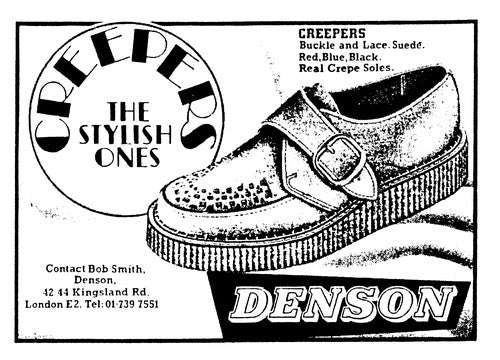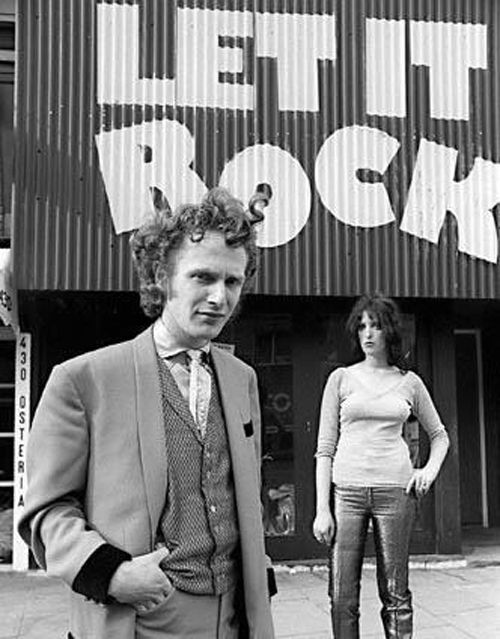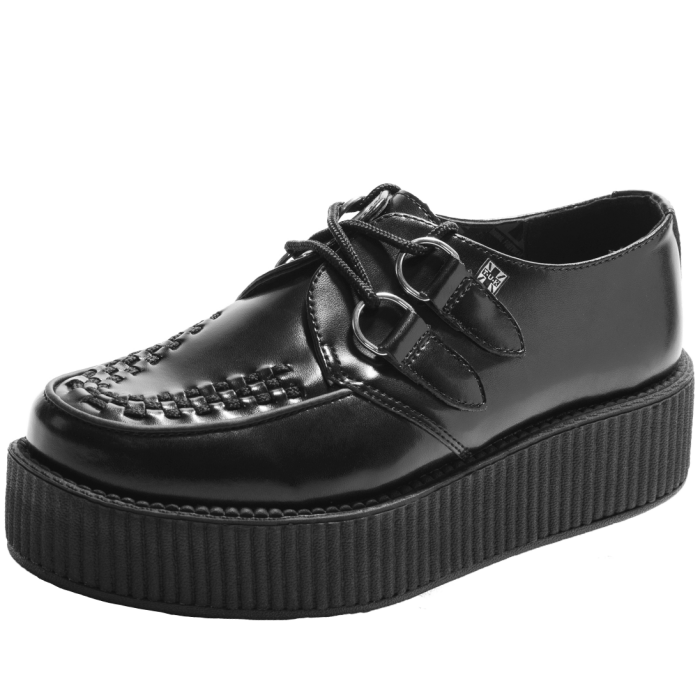News
T.U.K. Collaborates with Lara Hughes for an Unforgettable Final Year Designer Showcase
Designer Lara discusses her final year collection which was inspired by punk and rockabilly subcultures.
So you wanna buy punk shoes?
The history of the Mary Janes
Vintage Life Jeepers Creepers Coverage!
Do the Creep – a history of the Creeper shoe
Some footwear styles are made for trends but creepers are not one of them, they evolved... get a fascinating insight of how creepers came to fashion, read freelance writer Lee Powell's article featured in this months Vintageville Magazine.
It’s hard to imagine that a pair of functional desert boots worn by British soldiers in World War Two would become the iconic rock n roll footwear of teddyboys and rockabillies; but believe it or not, this is exactly the case!
Originally worn in the North African deserts, these thick souled crepe boots were ideal for helping deal with the extremities of the heat and the sandy terrain of the area. When the troops returned home the boots followed and found their way back to the shores of merry old England, where they continued to be worn and over time slowly caught on as a new fashionable design of footwear.

Shoe manufactures including Denson and Ladd's noticed the increasing numbers of ex-solders as well as civilians wearing these thick souled boots and taking inspiration from them developed the Creeper or ‘Brothel creeper’ as they become known. In 1949 George Hamilton Cox joined his father’s shoe making company and got got to work pioneering the companies signature shoe Creeper, which were marketed under the name ‘Hamilton’.
There is some speculation as to where these shoes inherited this nickname of ‘Brothel Creepers’ from but rumour has it that after their return from the war a number of soldiers in the capital wanted to experience some fun after years away fighting and found themselves in the dim neon lit back streets of Soho to enjoy its labyrinth of seedy adult entertainment. This is a wonderful story and if it’s true adds a wonderfully decedent grit to the shoes 60 plus year history.

Around the early 50’s a new youth scene, the Edwardians, later to be known as the teddyboys, was in its infancy and quickly adopted this new, innovative shoe design as their own. As the popularity of the teddyboys grew so in turn did their distinctive style of dress which incorporated the Creepers and thrust them into the limelight that the teddyboys found themselves in. As this scene grew ever more poplar clothing and footwear manufactures were quickly to jump on the band wagon and produce their own adaptions of the Teddyboy uniform and in turn made it easier to obtain but the drape suits and creepers, which exponential increased the number of youth’s becoming teddyboys and their public visibility. *
Towards the end of the 50’s and early 60’s a number of other rocking youth scenes; rockabillies, bikers and rockers, developed from the influence of US music and films which were being increasing popular in the UK. These groups along with the teddyboys were very much intertwined, all inhabiting the anti-social outskirts of teenage youth cultures and shared a common bond their love of rock n roll music. Although each group has their own distinctive style one often borrowed from the other and people in the scenes often moved from one to another as the years passed. This resulted in a cross pollination of styles to a certain degree and one element of clothing which transgressed each of these scenes with great ease was the ever distinctive creeper.
As is often the case fashions changed along with music and as the years moved into the 60’s the visual popularity of these rocking teenage youth cultures declined as others such as the mods increased and as such creepers were all but resigned to the dust-bin of fashions history except for a small army of die-hards who soldiered on with their scenes.

In the early 70’s two young disenfranchised Londoner’s, Vivienne Westwood and Malcolm McLaren, who both had an interested in 1950’s rebellious culture opened the now infamous ‘Let It Rock’ shop at 430 Kings Road. Westwood started making Teddyboy clothing for McLaren to sell, but his time with a modern, more in your face appearance than its 50’s predecessor. George Cox as an already established shoe manufacturer still existed although now focusing on producing other shoe designs, soon realised there was a growing interest in a newly popularised Teddy boy scene and with this came an interest in their creepers which were also sold in the shop
By 1972’ Let It Rock’ had become ‘Too fast to Live, Too Young to Die’ and changed its prominent stock from the neo-Edwardian wear of the teddy boys to the leather jackets and t-shirts of the rocker but still kept a stock of creepers and ordered in drape jackets for those who required them. Yet again there was a crossover of the teddyboy and rocker scenes and as before creepers were on prominent display with both genres. In a bid to push the mantel of fashion and tastes to the extremes by 1974 ‘Too Fast…’ became the infamous ‘Sex’ and shortly afterwards via the Sex Pistols and British punk McLaren turned music and fashion in its head and spat in the face of anyone who wasn’t willing to surrender to its spiky attitudes. Although at this time the “uniform” of the punk wasn’t wholly formulated as it was to become in later years and creeper became, for some time the punk’s footwear of choice. During this time however punk wasn’t the only music / fashion subculture on the rise. The reintroduction of the teddyboys some years previous had kick started the rock ‘n’ roll revival which pulled together legions of teddyboys, rockers and rockabillies, who as before donned the creepers as they had always done.

At the time the two subcultures went nose to nose and their fights became headline grabbing news stories, however as quickly as it had all stated it ended and the two went their merry way and occasionally met somewhere in the middle in the form of psychobilly. Yet throughout all of their differences one common denominator remained true, the creeper shoe.
Since the late 70’s and early 80’s the growth in interest in creepers remained on a steady incline being utilized by the rocking communities and punks alike. Then as they always do fashion and popular culture become interested in both scenes and although in the mainstream both had a slight decline during the 90’s, since the new millennium saw the light of day it opened up a huge chasm in the world of fashion and musical based subcultures where one borrowed heavily from the other. 5 or 6 years ago there were a handful of companies producing Creepers nowadays you can find endless reams of styles and variations online and even the odd pair on the local high-street.
There are still a number of shoe manufactures which specialise in creepers and this has slowly increased yet throughout the melee of change one scene has remained as true to the creepers as there were in the 50’s and today these wonderfully distinctive shoes still form a core element in the look of teddy boys, rockabillies, psychobillies and rock ‘n’ rollers all over the world.
As already stated there are a dizzying array of creepers available online and in the high-street. These vary from company to company as well as price and quality. Although cheaper creepers can act as a good introduction you’d be advised to invest in a pair form one of the specialist companies manufacturing them such as T.U.K as they are more likely to last years longer than some of the cheaper more fashion based designs.
*For a full history of creepers including images, see the article in January's issue of Vintageville Magazine here.
We would like to offer huge thanks to Lee Powell for allowing us use this article on our blog. Lee has some great images and content on his own blog you can check it out here.






